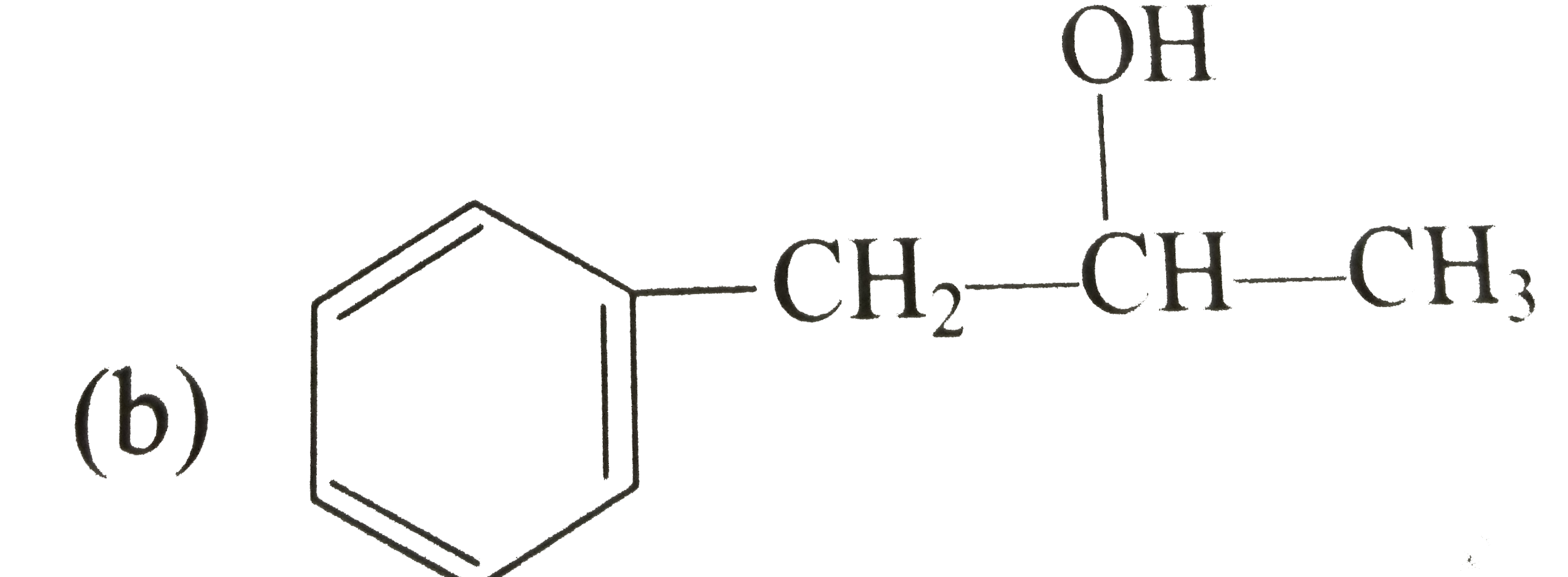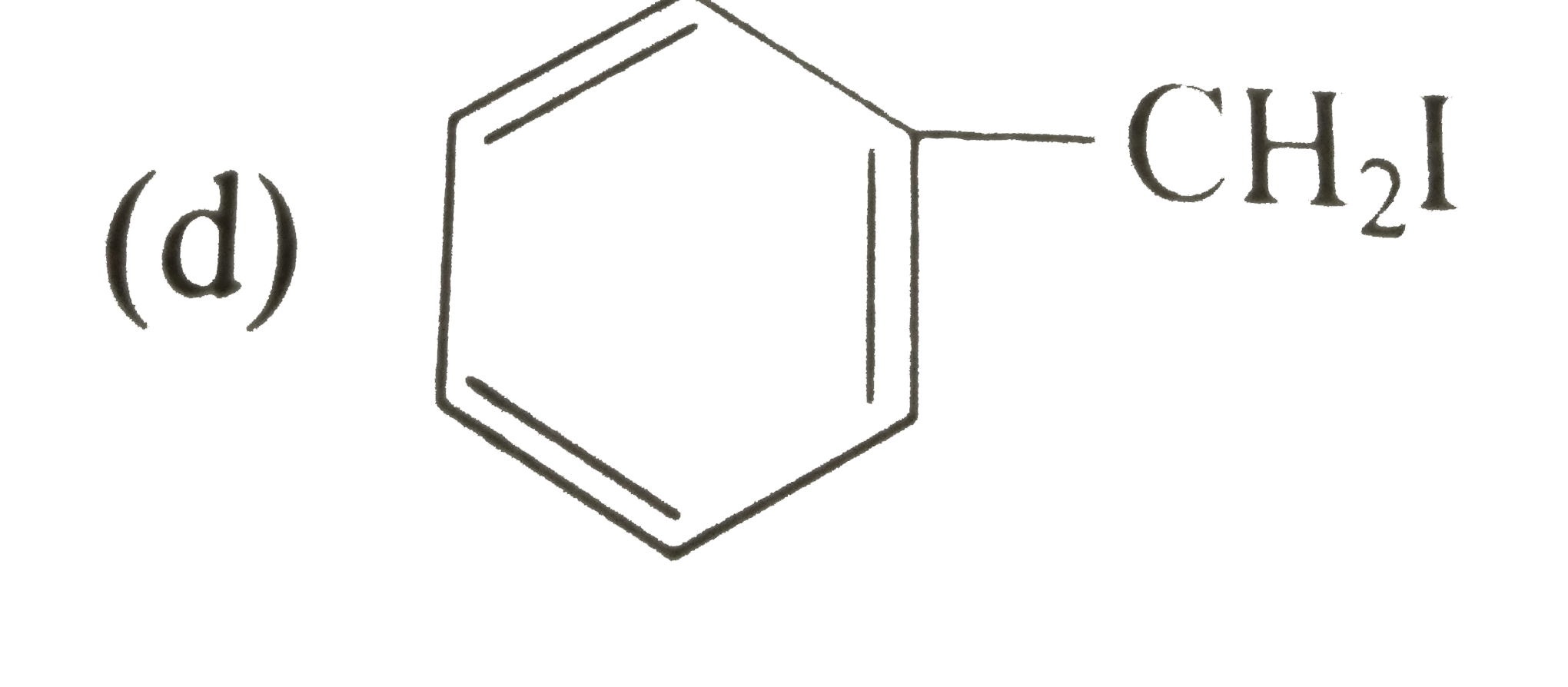An aromatic compound (A), C9H12O was subjeted to a series of tests in the laboratory. It was found that this compound ,
(i) does not form silver mirror with Tollens' reagent.
(ii) rotates the plane of polarised light.
(iii) reacts with sodium metal to evolve hydrogen gas. ltbr> (iv) does not decolourise pink colour of bromine water.
(v) reacts with hot KMnO4 to form monocarboxylic acid 'B' which on decarboxylation gives benzene.
(vi) reacts with Lucas reagent in about 5 min.
(vii) reacts with I2 and NaOH to produce yellow coloured precipitation of the compound (C ) .
(viii) loses its optical activity due to formation of compound (D ) on reaction with Red P and HI.
The compound (D ) will be :
C6H5CH2CH2CH3
C6H5CH2CH2COOH
C6H5CH2CH2CHO
C6H5CH2−O∣∣C−CH3
The correct Answer is:A
Topper's Solved these Questions
- BOOK - OP TANDONCHAPTER - ALCOHOLS, PHENOLS AND ETHERSEXERCISE - ETHERS Passage 65videos
ALCOHOLS, PHENOLS AND ETHERS
- BOOK - OP TANDONCHAPTER - ALCOHOLS, PHENOLS AND ETHERSEXERCISE - Passage 76videos
ALCOHOLS, PHENOLS AND ETHERS
- BOOK - OP TANDONCHAPTER - ALCOHOLS, PHENOLS AND ETHERSEXERCISE - Passage 45videos
ALCOHOLS, PHENOLS AND ETHERS
- BOOK - OP TANDONCHAPTER - ALDEHYDES AND KETONES EXERCISE - SINGLE INTEGER ANSWER TYPE QUESTIONS10videos
ALDEHYDES AND KETONES
Similar Questions

Which among the above compound/s does/do not form Silver mirror when treated with Tollen's reagent?View SolutionAn aromatic compound (A), C9H12O was subjeted to a series of tests in the laboratory. It was found that this compound ,
(i) does not form silver mirror with Tollens' reagent.
(ii) rotates the plane of polarised light.
(iii) reacts with sodium metal to evolve hydrogen gas. ltbr> (iv) does not decolourise pink colour of bromine water.
(v) reacts with hot KMnO4 to form monocarboxylic acid 'B' which on decarboxylation gives benzene.
(vi) reacts with Lucas reagent in about 5 min.
(vii) reacts with I2 and NaOH to produce yellow coloured precipitation of the compound (C ) .
(viii) loses its optical activity due to formation of compound (D ) on reaction with Red P and HI.
The functional groups present in the compound (A) is :View Solution
Knowledge Check
- Question 1 - Select One
An aromatic compound (A), C9H12O was subjeted to a series of tests in the laboratory. It was found that this compound ,
(i) does not form silver mirror with Tollens' reagent.
(ii) rotates the plane of polarised light.
(iii) reacts with sodium metal to evolve hydrogen gas. ltbr> (iv) does not decolourise pink colour of bromine water.
(v) reacts with hot KMnO4 to form monocarboxylic acid 'B' which on decarboxylation gives benzene.
(vi) reacts with Lucas reagent in about 5 min.
(vii) reacts with I2 and NaOH to produce yellow coloured precipitation of the compound (C ) .
(viii) loses its optical activity due to formation of compound (D ) on reaction with Red P and HI.
Structure of the compound (A ) will be :A B
B C
C Dnone of the above
Dnone of the above - Question 2 - Select One
An aromatic compound (A), C9H12O was subjeted to a series of tests in the laboratory. It was found that this compound ,
(i) does not form silver mirror with Tollens' reagent.
(ii) rotates the plane of polarised light.
(iii) reacts with sodium metal to evolve hydrogen gas. ltbr> (iv) does not decolourise pink colour of bromine water.
(v) reacts with hot KMnO4 to form monocarboxylic acid 'B' which on decarboxylation gives benzene.
(vi) reacts with Lucas reagent in about 5 min.
(vii) reacts with I2 and NaOH to produce yellow coloured precipitation of the compound (C ) .
(viii) loses its optical activity due to formation of compound (D ) on reaction with Red P and HI.
Molecular formula of the compound (C ) will be :ACH3IB CCHI3D
CCHI3D
- Question 3 - Select One
An aromatic compound (A), C9H12O was subjeted to a series of tests in the laboratory. It was found that this compound ,
(i) does not form silver mirror with Tollens' reagent.
(ii) rotates the plane of polarised light.
(iii) reacts with sodium metal to evolve hydrogen gas. ltbr> (iv) does not decolourise pink colour of bromine water.
(v) reacts with hot KMnO4 to form monocarboxylic acid 'B' which on decarboxylation gives benzene.
(vi) reacts with Lucas reagent in about 5 min.
(vii) reacts with I2 and NaOH to produce yellow coloured precipitation of the compound (C ) .
(viii) loses its optical activity due to formation of compound (D ) on reaction with Red P and HI.
Monocarboxylic acid (B) will be :AHCOOHBC6H5COOHCC6H5CH2CH2CH3DCH3COOH
An organic compound (A)C8H10O was subjected to a series of test in laboratory.
It was found that this compound :
(i) Rotates the plane polarized light.
(ii) Evolves H2 gas with Na.
(iii) Reaches with I2 and NaOH to produce yellow ppt.
(iv) Does not react with Br2/CCl4
(v) Reacts with hot KMnO4 to form (B)C7H6O2, which can also be synthesized by benzene and carbonyl chloride followed by hydrolysis.
(vi) Loses optical acitvity as a result of reduction with Red P+Hi to form C.
(vii) Reacts with Lucas reagent in about 5 minutes.
Find out structure of compound A:View SolutionAn organic compound (A) C8H10O was subjected to a series of test in laboratory. It was found that this compound :
(i) Rotates the plane polarized light
(ii) Evolves H2 gas with Na.
(iii)Reacts with I2 and NaOH to produce yellow ppt.
(iv) Does not react with Br2/CCl4
(v) Reats wtih not KMnO4 to form (B)C7H6O2, which can also be synthesized by benzene and carbonyl chloride followed by hydrolysis.
(vi) Loses optical activity as a result of reduction with Res P+HI to form 'C'
(vii) Reacts with Lucas reagent in about 5 minutes.
Find out structure of compound 'A' :View SolutionAn organic compound (A)C8H10O was subjected to a series of test in laboratory.
It was found that this compound :
(i) Rotates the plane polarized light.
(ii) Evolves H2 gas with Na.
(iii) Reaches with I2 and NaOH to produce yellow ppt.
(iv) Does not react with Br2/CCl4
(v) Reacts with hot KMnO4 to form (B)C7H6O2, which can also be synthesized by benzene and carbonyl chloride followed by hydrolysis.
(vi) Loses optical acitvity as a result of reduction with Red P+Hi to form C.
(vii) Reacts with Lucas reagent in about 5 minutes.
Compounds B and C are respectively:View SolutionThe compound which reacts with hydroxylamine but does not react with Tollen's reagent is
View SolutionAn organic compound (A) C8H10O was subjected to a series of test in laboratory. It was found that this compound :
(i) Rotates the plane polarized light
(ii) Evolves H2 gas with Na.
(iii)Reacts with I2 and NaOH to produce yellow ppt.
(iv) Does not react with Br2/CCl4
(v) Reats wtih not KMnO4 to form (B)C7H6O2, which can also be synthesized by benzene and carbonyl chloride followed by hydrolysis.
(vi) Loses optical activity as a result of reduction with Res P+HI to form 'C'
(vii) Reacts with Lucas reagent in about 5 minutes.
Compounds B and C are respectively :View Solution

